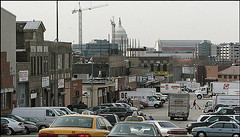People of the year: Us! (revised)

You've probably seen press coverage of Time Magazine's decision to make the ground-up users of the Internet as the "People of the Year." The cover story discusses:
community and collaboration on a scale never seen before. It's about the cosmic compendium of knowledge Wikipedia and the million-channel people's network YouTube and the online metropolis MySpace. It's about the many wresting power from the few and helping one another for nothing and how that will not only change the world, but also change the way the world changes.
I think about this sometimes, and not other times.
There is no question that the Web, blogs, community sharing places like Flickr (photos), YouTube (video), and Myspace (all kinds of things more socially oriented) allow for the connection of people in ways never really considered just a few years ago. It's what you make of it. These sites can be used by incredibly self-absorbed people, or as a way to connect and reach out, either personally, or in terms of civic involvement and engagement.
Blogs like DailyKos and Wonkette (and whatever the "conservative" ones are) can have tremendous impact on the political affairs of the day. Specialized websites and blogs aid in the creation of networks beyond geography and provide assistance and resource networks all over. (One of my most active correspondents is Nigel Foster from New Zealand...)
Locally, email and e-newsletters (particularly The Mail) are still especially important. DCist (and its siblings across the country), and the web presences of newspapers such as Free Ride, the blog companion to The Express, and City Desk, companion to the printed Washington City Paper, reach many people. I like how the online Washington Post harvests and includes blog links within entries also.
At the neighborhood level, blogs like Gallery Place Living and Frozen Tropics serve as tremendous resources for the people in their neighborhoods, containing news unlikely to make neither the local big newspapers nor the community papers, or at least not with the speed that the web allows.
Web and Internet sources, not just blogs, and in DC especially The Mail are places where journalists check in frequently, in search of stories. Adding significantly to the reach of an inherently narrowcasted/niche medium.
----------
Update:
KOB of the meta-website DC Blogs makes the point that the blogging phenomenon is much broader and deeper than I've made it out to be. DC Blogs attempts to keep track, or at least an eye, on area blogs--there are thousands.
And he points out something that I didn't mention, something very important--feeds. His blog has a live feed of noteworthy blogs, including this one. In the planning field a few feeds include this one also, Planetizen and Cyburbia, as does the broader news aggregator site Topix.
But anyone can feed virtually any blog, just by using RSS. (It happens I don't use RSS because I already can't keep up with all the email that I get, including e-newsletters. The last thing I need is more e-information. The web and printed material wipes me out as well.)
Brief on Real Simple Syndication.
This blog's RSS feed.
But his point is especially apt because it is another form of "push." Push webservices come to you, through email, RSS, or other means, while "pull" services such as websites and bulletin boards expect you to go to the site. I prefer push myself even though I don't do RSS, and pull sites for longer pieces, especially downloadable papers and reports.
And as you know, I make a point to have a pretty good set of links, there are over 1,000, and I am constantly adding links, and making sure they are active.
-----------------
As much as people (not this writer) complain about MSM or Main Stream Media, traditional media sources reach millions of people every day. Blogs reach hundreds or thousands. Fortunately, such readers are an important group of movers and shakers and officials and activists, so the reach is still significant.
Even if the "good people" still have a hard time winning. E.g., see "New Town Market Proposal Approved," subtitled "Questions Remain, Though, About Obligations of Mayor and Other Officials," from the Washington Post. (And it's frustrating that when the Post writes about unseemly political behavior, i.e., shenanigans albeit legally, it too rarely has the power to bring people down. This article is somewhat direct about some of this behavior.)
Capital and the well-connected still have a lot of power that people-power can counter, but only if we complement online organizing with ground-based organizing. If you don't believe me, ask Ned Lamont. Note to everyone, he lost.
 The New Town at Capital City Market project would transform a Northeast industrial site to condominiums, restaurants, a hotel and a smaller warehouse area. (By Nikki Kahn -- The Washington Post)
The New Town at Capital City Market project would transform a Northeast industrial site to condominiums, restaurants, a hotel and a smaller warehouse area. (By Nikki Kahn -- The Washington Post)But the bloggers need the MSM and I think the MSM needs the web and the increased demand for relevant information.
One blog entry, "You," from Maitri's Vatul Blog in New Orleans, makes the importance of the Internet as an information channel very clear. Maitri writes about Karen Gadbois, and all she is doing to enhance ground-up citizen engagement in the reconstruction process in New Orleans.
Of such connections and commitments communities are built, stabilized, maintained, and improved. Often at great sacrifice.
---------
Also see the Center for Citizen Journalism.
Index Keywords: civic-engagement



0 Comments:
Post a Comment
<< Home